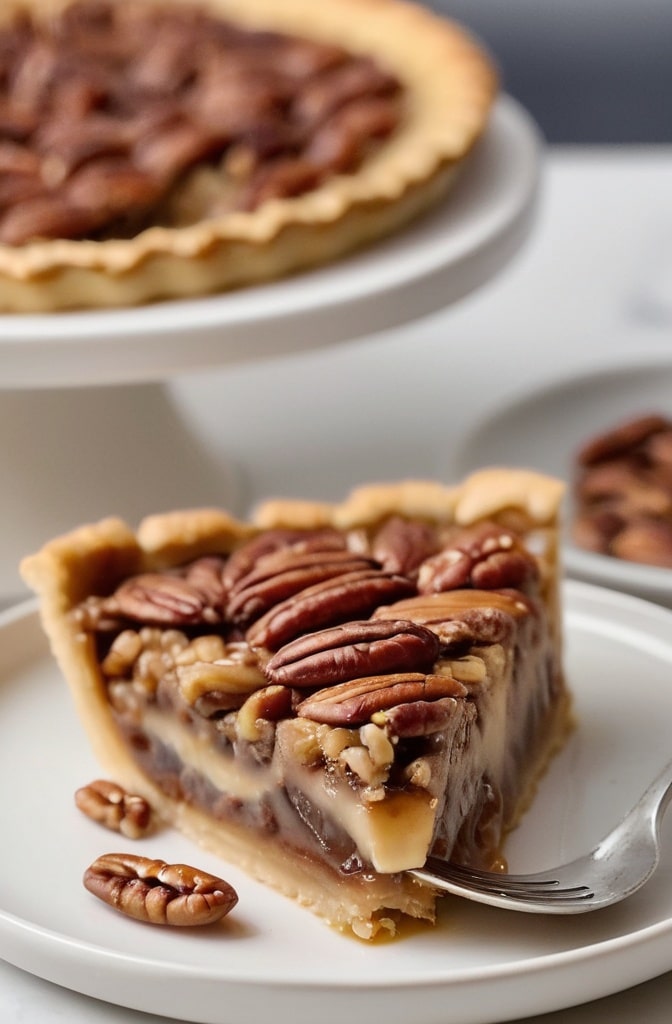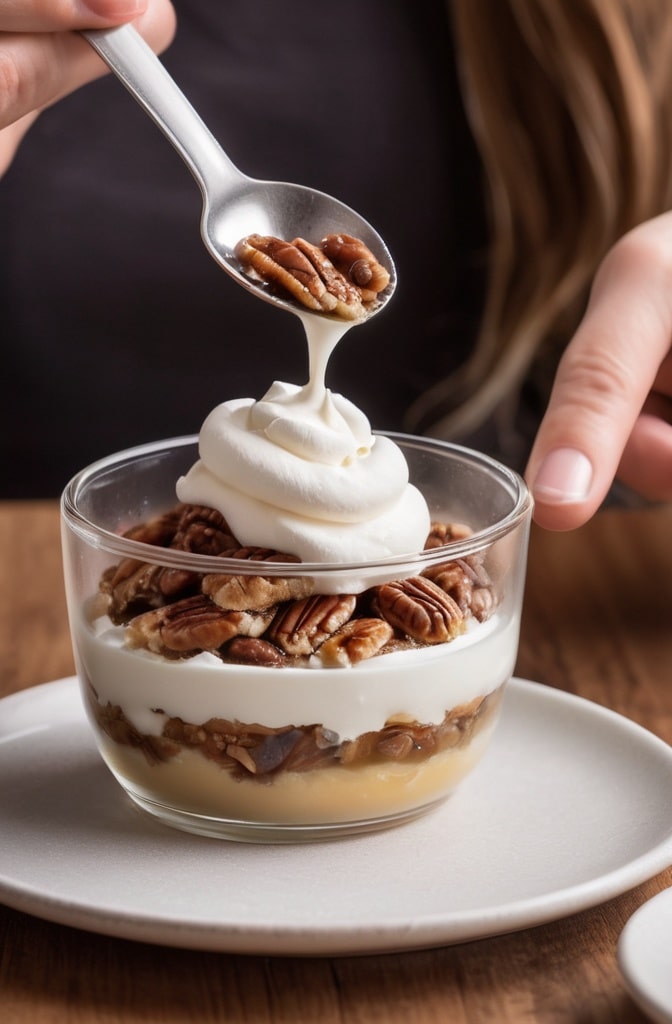The first time I encountered a properly executed Layered Pecan Pie Dessert Recipe, I was floored. It was in my grandmother’s kitchen in Lafayette, Louisiana, where southern hospitality meets culinary magic. The contrast between the buttery shortbread base, gooey caramel center, and that crown of perfectly toasted pecans created something far beyond your standard pecan pie. It was transcendent.
This dessert isn’t just another variation of pecan pie it’s an evolution that elevates the classic into something more nuanced, more texturally intresting, and dare I say, more impressive than its single-layer ancestor. By deconstructing the traditional pie into distinct layers, we create a dessert that delivers the beloved flavors of pecan pie but with architectural precision that makes each bite a journey through complementary textures and temperatures.
What Makes This Recipe Special
Traditional pecan pie is delicious but can sometimes be overwhelmingly sweet or texturally one-dimensional. This layered approach solves both problems. The shortbread base provides a buttery, crumbly foundation that stands up to the rich filling without getting soggy. The middle layer delivers that signature pecan pie gooeyness without being cloying. And the top layer of arranged pecans creates a textural finish that toasts beautifully, adding visual drama and nutty complexity.
It’s also incredibly adaptable for different serving situations. You can prepare it in a traditional pie dish for a homestyle presentation, in a springform pan for an elegant torte-like appearance, or in a rectangular baking dish for potlucks and gatherings where you need to feed a crowd. It travels better than traditional pecan pie, too—making it perfect for holiday contributions or dessert exchanges.
Ingredients & Substitutions
For the Shortbread Base
- 2 cups all-purpose flour (250g)
- ½ cup granulated sugar (100g)
- ¼ teaspoon salt
- 1 cup cold unsalted butter, cubed (225g)
- 1 teaspoon vanilla extract
- 1 large egg yolk
The shortbread base benefits tremendously from European-style butter with its higher butterfat content. If you’re dairy-free, a high-quality plant butter (like Miyoko’s) works surprizingly well, though you may need to add an extra tablespoon of flour to compensate for the diffrent moisture content. The egg yolk adds richness and helps bind everything together, but you can substitute 1 tablespoon of cornstarch mixed with 1 tablespoon water for an egg-free version.
For the Caramel Pecan Filling
- 1 cup packed dark brown sugar (200g)
- ⅔ cup golden syrup or light corn syrup (160ml)
- ⅓ cup pure maple syrup, Grade B preferred (80ml)
- 6 tablespoons unsalted butter (85g)
- ¼ teaspoon fine sea salt
- 1 tablespoon bourbon or dark rum (optional but recommended)
- 2 teaspoons vanilla extract
- 3 large eggs, room temperature
- 2 large egg yolks, room temperature
- 1½ cups roughly chopped pecans (150g)
The combination of dark brown sugar, golden syrup, and real maple syrup creates exceptional depth without being cloyingly sweet. Golden syrup (available in most supermarkets’ international sections) offers floral notes that corn syrup lacks, but you can use all corn syrup in a pinch. Similarly, the bourbon adds complexity that compliments the nuttiness, but a teaspoon of espresso powder dissolved in a tablespoon of hot water makes a fantastic non-alcoholic alternative.
For the Decorative Pecan Top
- 2 cups pecan halves (200g)
- 2 tablespoons melted butter
- 1 tablespoon maple syrup
- Pinch of flaky sea salt
For the top layer, intact pecan halves are worth the extra expense—they create that stunning visual impact. However, if budget is a concern, you can use chopped pecans tossed with the same glaze for a more rustic, equally delicious version. Other nuts like walnuts or a mixture can be substituted, though they’ll change the classic flavor profile.
Optional Enhancements
- ½ teaspoon ground cinnamon
- ¼ teaspoon freshly grated nutmeg
- 2 tablespoons dark chocolate chips (fold into filling)
- 1 tablespoon orange zest (add to shortbread base)
Step-by-Step Instructions

Preparing the Shortbread Base
- Preheat your oven to 350°F (175°C) and position a rack in the center. Prepare your chosen pan—either a 9-inch springform pan, a 9-inch deep pie dish, or a 9×13-inch rectangular baking pan—by lining the bottom with parchment paper and lightly buttering the sides.
- In a food processor, pulse the flour, sugar, and salt together briefly to combine. Add the cold cubed butter and pulse until the mixture resembles coarse sand with some pea-sized butter pieces remaining—this inconsistant texture is actually crucial for a tender shortbread. Don’t overprocess! Those little butter chunks create flakiness.
- Add the vanilla and egg yolk, pulsing just until the dough starts to come together when pinched. It should still look somewhat crumbly but hold together when pressed. Many bakers make the mistake of adding more liquid when the dough seems dry, but patience is key—it will come together when pressed into the pan.
- Turn the mixture into your prepared pan and press firmly using the bottom of a measuring cup to create an even layer. If using a springform or pie dish, bring the crust about 1½ inches up the sides. For a rectangular pan, just create an even base.
- Prick the base all over with a fork (this prevents bubbling) and chill for 20 minutes in the freezer or 40 minutes in the refrigerator. This critical step prevents shrinkage during baking.
- Bake the chilled crust for 15-18 minutes until barely golden at the edges but not fully baked. It’ll continue baking when we add the filling. Remove and reduce the oven temperature to 325°F (165°C).
A common mistake is overbaking the shortbread base at this stage—it should be just set but not browned, as it will continue to bake once the filling is added. If you notice the edges browning too quickly, shield them with small pieces of foil.
Creating the Caramel Pecan Filling
- In a medium saucepan over medium-low heat, combine the brown sugar, golden syrup, maple syrup, butter, and salt. Stir occasionally until the butter is melted and the mixture is smooth and just starting to simmer around the edges. Remove from heat and let cool for about 10 minutes—adding eggs to a too-hot mixture is a recipe for sugary scrambled eggs!
- While the mixture cools, whisk the eggs and egg yolks together in a large bowl until well combined. The extra yolks contribute to that silky, custardy texture that elevates this dessert.
- Very gradually, pour the cooled syrup mixture into the eggs in a thin stream while whisking constantly. This tempering step is essential—if you add the eggs to hot syrup or dump all the syrup in at once, you’ll end up with curdled eggs instead of smooth custard.
- Whisk in the bourbon (if using) and vanilla extract. If you’re adding any optional spices like cinnamon or nutmeg, incorporate them now.
- Fold in the chopped pecans, making sure they’re evenly distributed throughout the filling. If you’re including chocolate chips, now’s the time to add those too—they’ll create lovely molten pockets in the finished dessert.
The filling should have a glossy, pourable consistency that’s not too thick or thin. If it seems overly runny, let it stand for 5 minutes to thicken slightly before pouring.
Assembling and Baking the Dessert
- Pour the prepared filling over the par-baked shortbread base, using a spatula to ensure even distribution all the way to the edges. The filling should come to about ¼ inch below the edge of the crust (it will puff slightly during baking).
- For the decorative top, toss the pecan halves with melted butter and maple syrup until evenly coated. This coating is both functional and flavorful—it helps the nuts toast beautifully without burning.
- Arrange the glazed pecans on top of the filling in your preferred pattern—concentric circles create a classical look, while a herringbone pattern offers modern elegance. For a rectangular pan, rows of slightly overlapping pecans work beautifuly. Whatever pattern you choose, place them with their dome sides up for the most attractive appearance.
- Sprinkle the arranged pecans lightly with flaky sea salt. This final touch balances the sweetness and makes the flavors sing.
- Bake at 325°F (165°C) for 45-55 minutes for a round pan, or 35-40 minutes for a rectangular pan. The filling should be mostly set but still have a slight jiggle in the center—similar to how you’d want a cheesecake. The edges will be more set than the middle, which is perfect.
- Cool completely on a wire rack for at least 3 hours before serving. This resting period is non-negotiable—it allows the filling to fully set and the flavors to meld. For clean slices, refrigerate for 1-2 hours after cooling to room temperature.
One common mistake is underbaking because the center seems too wobbly. Trust the process—the residual heat will continue cooking the filling as it cools. Overbaking leads to a dry, cracked filling rather than that luscious, silky texture we’re after.
Cooking Techniques & Science
The success of this layered dessert relies on several key techniques and scientific principles that are worth understanding if you want to achieve consistent results.
First, the shortbread base utilizes the “shortening” power of butter to create that characteristic crumbly texture. The term “short” in baking refers to the way fat coats flour particles, preventing them from forming long gluten strands. This is why we pulse rather than process the butter—those small chunks of butter create steam pockets during baking, resulting in flaky layers. The cold butter and minimal handling are crucial for maintaining this texture.

The filling employs a custard-based chemistry, where eggs proteins coagulate when heated to create structure within a sugar solution. This is why we’re so careful about tempering—rapid protein coagulation leads to curdling rather than smooth custard. The addition of acid (from the brown sugar) and fat (from the butter) helps buffer this process, allowing for a wider margin of success.
The distinct layers are preserved through temperature control and baking order. The par-baked crust creates a barrier that resists soaking up moisture from the filling. Meanwhile, the higher position of the decorative pecans in the oven causes them to toast more quickly than if they were submerged in the filling. This selective browning, known as the Maillard reaction, enhances the nutty flavors through the creation of hundreds of new flavor compounds.
An invaluable tool for this recipe is an oven thermometer—most home ovens can be off by 25°F or more, which significantly impacts baking times and results. Similarly, a digital instant-read thermometer can help determine when the filling is properly set (it should reach 175°F in the center).
Serving & Pairing Suggestions
This layered pecan pie dessert deserves thoughtful presentation and complementary pairings to showcase its sophistication.
For a classic presentation, serve slightly warm (not hot) with a quenelle of lightly whipped cream spiced with bourbon and vanilla. The contrast between the warm dessert and cool cream creates a sensory delight. Alternatively, a small scoop of brown butter ice cream or buttered pecan ice cream amplifies the nutty notes while adding temperature contrast.
If serving as part of a dessert course, consider plating with a small drizzle of aged balsamic reduction and three fresh raspberries for color and acidic balance. A light dusting of cocoa powder on one side of the plate adds visual drama and hints at chocolate without overwhelming the pecan flavors.
For beverages, this dessert pairs beautifully with aged spirits—a small pour of 10-year bourbon, Armagnac, or Pedro Ximénez sherry complements the caramel and nut flavors. Non-alcoholic pairings include a rich coffee service (pourover or French press rather than espresso) or a spiced chicory coffee that echoes the southern roots of pecan pie.
When serving a crowd, pre-slice and arrange pieces on a wooden board with small bowls of different accompaniments—whipped cream, dulce de leche, chocolate sauce—allowing guests to customize their experience. Garnish the board with additional toasted pecans and perhaps some edible flowers for seasonal charm.
This dessert holds well at room temperature for several hours, making it ideal for holiday gatherings where food may sit out during extended celebrations. For make-ahead convenience, the entire dessert can be prepared up to three days in advance and refrigerated, though it’s best brought to room temperature before serving to allow the caramel notes to fully express themselves.
Conclusion
The layered pecan pie dessert represents everything wonderful about evolutionary cooking—honoring traditional flavors while improving upon execution and presentation. The clear separation of textures—crumbly shortbread, gooey caramel filling, and toasted pecan crown—creates a dessert that’s greater than the sum of its parts.
What makes this recipe truly special is its versatility and reliability. The techniques, while requiring attention to detail, aren’t complicated—they simply require respect for temperature, timing, and ingredient quality. Master this dessert, and you’ll have a signature dish that works as well for holiday gatherings as it does for impressive dinner party finales.
One final piece of advice: don’t rush this dessert. From properly chilling the shortbread to allowing adequate cooling time, each waiting period contributes to the final quality. In our fast-paced culinary world, this recipe reminds us that sometimes the most important ingredient is patience.
FAQs About Layered Pecan Pie Dessert Recipe
Can I make this dessert gluten-free?
Absolutely! The shortbread base adapts beautifully to gluten-free flours. Your best bet is a cup-for-cup blend that contains xanthan gum. Add 1/4 teaspoon of almond extract to enhance flavor, as gluten-free flours can sometimes taste a bit flat. The filling is naturally gluten-free, assuming your syrup brands don’t contain gluten additives.
How far in advance can I make this dessert?
You can prepare the entire dessert up to 3 days ahead and refrigerate it, covered loosely with foil rather than plastic wrap (which can trap too much moisture). For longer storage, the unbaked shortbread base can be frozen for up to a month, and the entire baked dessert freezes well for up to 2 weeks. Thaw overnight in the refrigerator, then bring to room temperature before serving.
My filling cracked during cooling. What went wrong?
Cracking usually indicates overbaking or too-rapid temperature changes. Next time, bake until the filling registers 175°F in the center, even if it seems too jiggly. Allow the dessert to cool in the turned-off oven with the door cracked for 30 minutes before moving to room temperature. For this batch, a light dusting of powdered sugar or a strategic placement of whipped cream can disguise the cracks without affecting flavor.
Can I use this recipe to make individual tartlets instead of one large dessert?
Definitely! This recipe converts beautifully to individual servings. Use a muffin tin lined with parchment rounds for easy removal. Reduce the baking time to about 20-25 minutes for the shortbread base and 15-20 minutes for the filled tartlets. This format is particularly elegant for formal dinner parties where plated desserts enhance the dining experience.
The pecans on top taste slightly bitter. How can I prevent this?
Bitter pecans usually indicate slight burning of the natural oils. Next time, tent the dessert with foil after the first 30 minutes of baking to prevent the nuts from over-toasting. Also, be sure you’re using fresh pecans—nuts can become rancid if stored improperly or too long, creating bitterness. Always store unused nuts in the freezer to preserve freshness and natural sweetness.

